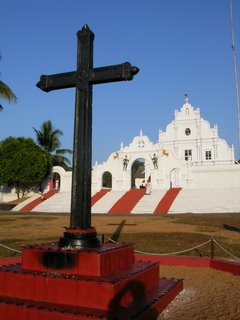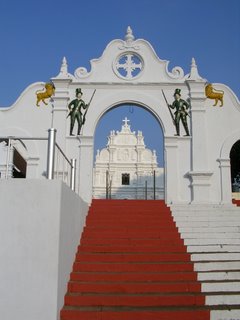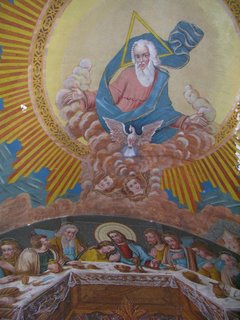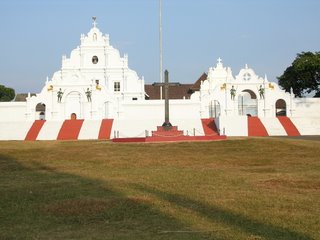
by Ranjith Ouseppe
Nestled majestically on top of a knoll with the town at its feet and constantly under vigil by the gun-wielding carabineers and the roaring lions, the Ramapuram twin churches are one of the most arresting and imposing sights that one can hope to see in a lifetime. Unique in its rare blending of Indo-Persian and Portuguese architectural styles, the twin churches straddle the history and memories of more than half a millennium of Ramapuram's existence. As with the origin of many a church, the history of Ramapuram church is also steeped in a legend. And the legend goes thus: 
During the early 15th century, the Ramapuram Christians had as their parish church the famous Kuravilangad church, which meant that they had to travel all that distance to attend a Mass. So, on this Easter eve some 600 odd years back a certain old woman started on her long -and momentous- walk to Kuravilangad but alas fate decreed that she not reach there.Stranded midway on the hillock of Koozhamala she heard the Easter bells ringing in the far off church.Kneeling down then and there she whispered her prayers and made the vow that was to result in the creation of the Ramapuram church, the solemn vow being that she would not receive the sacrament till the day a church at Ramapuram became a reality.
She indicated her wish to Cholapallil Rev. Yousseppachan, then a priest in Pala, who with the influence of the local minister succeeded in getting the permission granted. The land for the new church was granted free by the Vallichira Kaimal and the old woman's dream of a local church fructified somewhere around the year 1450 when the church was consecrated in the name of the Blessed Virgin.
The smaller of the twin churches we see now at Ramapuram was built in the year 1599 and rededicated to St. Augustine as the then Portuguese Archbishop Dom Alexis De Menezes was an Augustinian. The golden altar of this church is of exquisite beauty and the woodcarvings a joy for ever. The vault is magnificently adorned with frescoes faded by time and incense. The altar of the original church dedicated to the Blessed Virgin has been well preserved in the sacristy and strikingly resembles the murals in the Hindu Temples. Upstairs, behind the altar are the council hall and the living quarters of the priests. It was here that for half a millennium the church council met but is now the haunt of bats and spiders. The balustrades, pilasters and overall construction of the church vouch for the Portuguese influence on the construction as do the carabineers and the regal lions that guard the entrance.
The mortal remains of the Governodor of Kodungallor Rev. Paremmakkal Thoma kattanar are interred here. From 1786 until his death in 1799 Paremmakkal Kattanar officiated over the Kodungalloor archdiocese from his presbytery which flanks the church precincts. Rev Paremmakkal has the distinction of being the author of the first travelogue written in any Indian language, about his journey with Mar. Kariyatti to Rome and the Portuguese Queens court to petition the Queen on enforcing the PADROADO (exclusive rights granted by Rome to the Portuguese crown for the appointment of bishops in newly discovered areas, and which the Carmelites of Rome later tried to circumvent) against the PROPOGANDA regime of Rome and also in getting an indigenous clergyman elected as their bishop.
The Blessed Kunjachan who took the message of the Gospel to the downtrodden is also entombed in the church and thousands make their pilgrimage here every year, especially for his feast on the 16th of October.
 The 'Big Church' was erected in 1864 and dedicated to The Blessed Virgin in memory of the first consecration. Almost a carbon copy of the smaller church, its sturdy walls almost four feet thick symbolize the unassailability and strength of the faith of our forefathers who constructed this magnificent edifice solely by the sweat of their brows. Succeeding generations have painted over parts of its beautiful murals and a transept which in no way blends with the main church has been added in the recent past abutting the left side of the church. The church's ornately carved high altar and the frescoes of the Last Judgement in the vault are sights to behold, invoking visions of the Sistine chapel. Where human hands have failed to reach, beauty survives, as in the unique fresco of the Holy Trinity with the singularly striking Triangle halo, whose gaze always seems to follow us.
The 'Big Church' was erected in 1864 and dedicated to The Blessed Virgin in memory of the first consecration. Almost a carbon copy of the smaller church, its sturdy walls almost four feet thick symbolize the unassailability and strength of the faith of our forefathers who constructed this magnificent edifice solely by the sweat of their brows. Succeeding generations have painted over parts of its beautiful murals and a transept which in no way blends with the main church has been added in the recent past abutting the left side of the church. The church's ornately carved high altar and the frescoes of the Last Judgement in the vault are sights to behold, invoking visions of the Sistine chapel. Where human hands have failed to reach, beauty survives, as in the unique fresco of the Holy Trinity with the singularly striking Triangle halo, whose gaze always seems to follow us.  This singular fresco adorns the vault of the side chapel on the left where we tread on vitreous tiles of great brilliance. A beautifully filigreed brass lantern still sheds a quaint light in the nave as it has been for more than two lifetimes. Guarded by cherubs and seraphim of myriad sizes and forms Our Father benevolently gazes down from the altar tops. The stained glass windows cast an ethereal light and the cooing and flapping of the omnipresent rock pigeons lures one into an eternal communion with God. The mighty wooden doors are bolted by sliding wooden beams so strong as if to keep out the devil himself and 12 sturdy columns on the veranda stand tall challenging even Samson.
This singular fresco adorns the vault of the side chapel on the left where we tread on vitreous tiles of great brilliance. A beautifully filigreed brass lantern still sheds a quaint light in the nave as it has been for more than two lifetimes. Guarded by cherubs and seraphim of myriad sizes and forms Our Father benevolently gazes down from the altar tops. The stained glass windows cast an ethereal light and the cooing and flapping of the omnipresent rock pigeons lures one into an eternal communion with God. The mighty wooden doors are bolted by sliding wooden beams so strong as if to keep out the devil himself and 12 sturdy columns on the veranda stand tall challenging even Samson.
The facade sports reliefs of many slender columns in pairs with decorative capitals and motifs, with those of small church being more elaborate and adorned with a plethora of bestial and angelic forms. The vadyapuras still echo the musical notes from a bygone era. And a stone crucifix as old as God Himself stands as a sentinel in the church meadow, watching the ages pass...


During the early 15th century, the Ramapuram Christians had as their parish church the famous Kuravilangad church, which meant that they had to travel all that distance to attend a Mass. So, on this Easter eve some 600 odd years back a certain old woman started on her long -and momentous- walk to Kuravilangad but alas fate decreed that she not reach there.Stranded midway on the hillock of Koozhamala she heard the Easter bells ringing in the far off church.Kneeling down then and there she whispered her prayers and made the vow that was to result in the creation of the Ramapuram church, the solemn vow being that she would not receive the sacrament till the day a church at Ramapuram became a reality.
She indicated her wish to Cholapallil Rev. Yousseppachan, then a priest in Pala, who with the influence of the local minister succeeded in getting the permission granted. The land for the new church was granted free by the Vallichira Kaimal and the old woman's dream of a local church fructified somewhere around the year 1450 when the church was consecrated in the name of the Blessed Virgin.
The smaller of the twin churches we see now at Ramapuram was built in the year 1599 and rededicated to St. Augustine as the then Portuguese Archbishop Dom Alexis De Menezes was an Augustinian. The golden altar of this church is of exquisite beauty and the woodcarvings a joy for ever. The vault is magnificently adorned with frescoes faded by time and incense. The altar of the original church dedicated to the Blessed Virgin has been well preserved in the sacristy and strikingly resembles the murals in the Hindu Temples. Upstairs, behind the altar are the council hall and the living quarters of the priests. It was here that for half a millennium the church council met but is now the haunt of bats and spiders. The balustrades, pilasters and overall construction of the church vouch for the Portuguese influence on the construction as do the carabineers and the regal lions that guard the entrance.

The mortal remains of the Governodor of Kodungallor Rev. Paremmakkal Thoma kattanar are interred here. From 1786 until his death in 1799 Paremmakkal Kattanar officiated over the Kodungalloor archdiocese from his presbytery which flanks the church precincts. Rev Paremmakkal has the distinction of being the author of the first travelogue written in any Indian language, about his journey with Mar. Kariyatti to Rome and the Portuguese Queens court to petition the Queen on enforcing the PADROADO (exclusive rights granted by Rome to the Portuguese crown for the appointment of bishops in newly discovered areas, and which the Carmelites of Rome later tried to circumvent) against the PROPOGANDA regime of Rome and also in getting an indigenous clergyman elected as their bishop.
The Blessed Kunjachan who took the message of the Gospel to the downtrodden is also entombed in the church and thousands make their pilgrimage here every year, especially for his feast on the 16th of October.
 The 'Big Church' was erected in 1864 and dedicated to The Blessed Virgin in memory of the first consecration. Almost a carbon copy of the smaller church, its sturdy walls almost four feet thick symbolize the unassailability and strength of the faith of our forefathers who constructed this magnificent edifice solely by the sweat of their brows. Succeeding generations have painted over parts of its beautiful murals and a transept which in no way blends with the main church has been added in the recent past abutting the left side of the church. The church's ornately carved high altar and the frescoes of the Last Judgement in the vault are sights to behold, invoking visions of the Sistine chapel. Where human hands have failed to reach, beauty survives, as in the unique fresco of the Holy Trinity with the singularly striking Triangle halo, whose gaze always seems to follow us.
The 'Big Church' was erected in 1864 and dedicated to The Blessed Virgin in memory of the first consecration. Almost a carbon copy of the smaller church, its sturdy walls almost four feet thick symbolize the unassailability and strength of the faith of our forefathers who constructed this magnificent edifice solely by the sweat of their brows. Succeeding generations have painted over parts of its beautiful murals and a transept which in no way blends with the main church has been added in the recent past abutting the left side of the church. The church's ornately carved high altar and the frescoes of the Last Judgement in the vault are sights to behold, invoking visions of the Sistine chapel. Where human hands have failed to reach, beauty survives, as in the unique fresco of the Holy Trinity with the singularly striking Triangle halo, whose gaze always seems to follow us.  This singular fresco adorns the vault of the side chapel on the left where we tread on vitreous tiles of great brilliance. A beautifully filigreed brass lantern still sheds a quaint light in the nave as it has been for more than two lifetimes. Guarded by cherubs and seraphim of myriad sizes and forms Our Father benevolently gazes down from the altar tops. The stained glass windows cast an ethereal light and the cooing and flapping of the omnipresent rock pigeons lures one into an eternal communion with God. The mighty wooden doors are bolted by sliding wooden beams so strong as if to keep out the devil himself and 12 sturdy columns on the veranda stand tall challenging even Samson.
This singular fresco adorns the vault of the side chapel on the left where we tread on vitreous tiles of great brilliance. A beautifully filigreed brass lantern still sheds a quaint light in the nave as it has been for more than two lifetimes. Guarded by cherubs and seraphim of myriad sizes and forms Our Father benevolently gazes down from the altar tops. The stained glass windows cast an ethereal light and the cooing and flapping of the omnipresent rock pigeons lures one into an eternal communion with God. The mighty wooden doors are bolted by sliding wooden beams so strong as if to keep out the devil himself and 12 sturdy columns on the veranda stand tall challenging even Samson.The facade sports reliefs of many slender columns in pairs with decorative capitals and motifs, with those of small church being more elaborate and adorned with a plethora of bestial and angelic forms. The vadyapuras still echo the musical notes from a bygone era. And a stone crucifix as old as God Himself stands as a sentinel in the church meadow, watching the ages pass...

